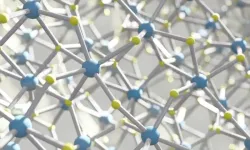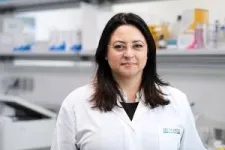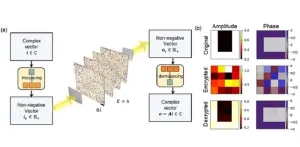(Press-News.org) EMBARGOED: NOT FOR RELEASE UNTIL 3:00 P.M. U.S. EASTERN TIME ON JANUARY 22, 2024
Scientists and engineers have been pushing for the past decade to leverage an elusive ferroelectric material called hafnium oxide, or hafnia, to usher in the next generation of computing memory. A team of researchers including the University of Rochester’s Sobhit Singh published a Proceedings of the National Academy of Sciences study outlining progress toward making bulk ferroelectric and antiferroelectric hafnia available for use in a variety of applications.
In a specific crystal phase, hafnia exhibits ferroelectric properties—that is, electric polarization that can be changed in one direction or another by applying an external electric field. This feature can be harnessed in data storage technology. When used in computing, ferroelectric memory has the benefit of non-volatility, meaning it retains its values even when powered off, one of several advantages over most types of memory used today.
“Hafnia is a very exciting material because of its practical applications in computer technology, especially for data storage,” says Singh, an assistant professor in the Department of Mechanical Engineering. “Currently, to store data we use magnetic forms of memory that are slow, require a lot of energy to operate, and are not very efficient. Ferroelectric forms of memory are robust, ultra-fast, cheaper to produce, and more energy-efficient.”
But Singh, who performs theoretical calculations to predict material properties at the quantum level, says that bulk hafnia is not ferroelectric at its ground state. Until recently, scientists could only get hafnia to its metastable ferroelectric state when straining it as a thin, two-dimensional film of nanometer thickness.
In 2021, Singh was part of a team of scientists at Rutgers University that got hafnia to stay at its metastable ferroelectric state by alloying the material with yttrium and rapidly cooling it. Yet this approach had some drawbacks. “It required a lot of yttrium to get to that desired metastable phase,” he says. “So, while we achieved what we were going for, at the same time we were hampering a lot of the material’s key features because we were introducing a lot of impurities and disorder in the crystal. The question became, how can we get to that metastable state with as little yttrium as possible to improve the resulting material’s properties?”
In the new study, Singh calculated that by applying significant pressure, one could stabilize bulk hafnia in its metastable ferroelectric and antiferroelectric forms—both of which are intriguing for practical applications in next-generation data and energy storage technologies. A team led by Professor Janice Musfeldt at the University of Tennessee, Knoxville, carried out the high-pressure experiments and demonstrated that, at the predicted pressure, the material converted into the metastable phase and remained there even when pressure was removed.
“This is as an excellent example of experimental-theoretical collaboration”, says Musfeldt.
The new approach required only about half as much yttrium as a stabilizer, thereby considerably improving the quality and purity of the grown hafnia crystals. Now, Singh says that he and the other scientists will push to use less and less yttrium until they figure out a way for producing ferroelectric hafnia in bulk for widespread use.
And as hafnia continues to draw increasing attention due to its intriguing ferroelectricity, Singh is organizing an invited focus session on the material at the upcoming American Physical Society’s March Meeting 2024.
END
Manipulated hafnia paves the way for next-gen memory devices
Scientists outline new processes for leveraging hafnia’s ferroelectric features with the aim of enhancing high-performance computing.
2024-01-22
ELSE PRESS RELEASES FROM THIS DATE:
Optical computing boost with diffractive network advance
2024-01-22
State-of-the-art neural networks heavily rely on linear operations, such as matrix-vector multiplications and convolutions. While dedicated processors like GPUs and TPUs exist for these operations, they have limitations in terms of power consumption and bandwidth. Optics is better suited for such operations because of its inherent parallelism, large bandwidth, and computation speed.
Diffractive deep neural networks (D2NN), also known as diffractive networks, constitute an emerging optical computing architecture. ...
Wake Forest Institute for Regenerative Medicine (WFIRM) to lead $40 Million initiative for AFIRM Consortium
2024-01-22
Winston Salem, NC – January 22, 2024 - The Wake Forest Institute for Regenerative Medicine, part of Wake Forest University School of Medicine, has been selected to lead the Armed Forces Institute of Regenerative Medicine (AFIRM) Consortium. The project - a $40 million, five year-long award from the Defense Health Agency (DHA) - will focus on taking regenerative medicine solutions for battlefield injuries to the next level, and ultimately to the general public.
Regenerative medicine is a science that takes advantage of the body's natural abilities to restore or replace damaged tissue and organs. WFIRM has managed two prior AFIRM consortia since ...
Argonne National Laboratory flexes capabilities with receipt of four nuclear innovation vouchers
2024-01-22
A decade that began with a global shutdown is a third of the way done. Its finale — a major deadline for reducing U.S. carbon emissions to slow climate change — approaches at the usual clip. With the decade’s halfway mark in view, the U.S. Department of Energy (DOE) Gateway for Accelerated Innovation in Nuclear (GAIN) awarded seven new vouchers to companies and national laboratories working to develop and commercialize clean nuclear energy projects. Nuclear energy is considered central to efforts to minimize carbon emissions and still reliably meet rising ...
Strategy to boost prostate cancer treatment efficacy devised at Rutgers Health
2024-01-22
Rutgers researchers can predict which patients will benefit from a popular prostate cancer drug – and have devised a strategy that may make the treatment work longer.
“This work should help doctors know which patients’ prostate cancers will and won’t respond to the androgen deprivation therapy enzalutamide, which can slow prostate cancer growth by disrupting androgen receptor signaling,” said Antonina Mitrofanova, associate professor of Biomedical and Health Informatics, associate dean for research at the Rutgers School of Health Professions, researcher at Rutgers Cancer ...
Salad in space? New study says it's not a healthy choice
2024-01-22
Lettuce and other leafy green vegetables are part of a healthy, balanced diet — even for astronauts on a mission.
It’s been more than three years since the National Aeronautics and Space Administration made space-grown lettuce an item on the menu for astronauts aboard the International Space Station. Alongside their space diet staples of flour tortillas and powdered coffee, astronauts can munch on a salad, grown from control chambers aboard the ISS that account for the ideal temperature, amount of water and light ...
Sexual minority young people in Canada more likely to experience harmful police contact
2024-01-22
Toronto, ON – While there has been much public scrutiny and research on police interactions and violence towards sexual minorities in the United States, there is a gap in the current literature on how sexual minorities fare with law enforcement contact in Canada. A new study published in the Annals of Epidemiology aims to fill this research gap by examining the relationship between sexual orientation and experiences with police contact, including intrusion and harassment from the police, in Canada.
Among a sample of 940 adolescents and young adults across Canada, the study found that the prevalence of police contact was highest among persons ...
University Hospitals OBGYN and urologist Joseph Welles Henderson, MD, named InterStim™ Center of Excellence
2024-01-22
CLEVELAND -- Joseph Welles Henderson, MD, of University Hospitals has been named an InterStim™ Center of Excellence by Medtronic (NYSE: MDT), the world’s largest medical device manufacturer. The designation is awarded to caregivers who have demonstrated particular expertise in the use of the InterStim™ system to treat overactive bladder, as well as non-obstructive urinary retention and chronic fecal incontinence.
Dr. Henderson is an OBGYN and urologist, and specializes in female pelvic medicine and reconstruction ...
Thinning of brain region may signal dementia risk 5-10 years before symptoms
2024-01-22
SAN ANTONIO, Jan. 22, 2024 — A ribbon of brain tissue called cortical gray matter grows thinner in people who go on to develop dementia, and this appears to be an accurate biomarker of the disease five to 10 years before symptoms appear, researchers from The University of Texas Health Science Center at San Antonio (also called UT Health San Antonio) reported.
The researchers, working with colleagues from The University of California, Davis, and Boston University, conducted an MRI brain imaging study published ...
Zeng researching techniques for achieving supply chain security for the Internet of Things
2024-01-22
Qiang Zeng, Associate Professor, Computer Science, received funding for the project: "Towards Lifetime Supply Chain Security for Internet of Things: Testing an Update Before Trusting It."
The global Internet of Things (IoT) market size is expected to rise substantially by 2029. IoT devices are manufactured by various companies around the world, and thus, should not be trusted by default. Zeng aims to ensure lifetime supply chain security of IoT devices. To attain this objective, he is proposing to test an IoT device and every firmware update through ...
Arafin conducting research aimed at securing chiplet-based semiconductor manufacturing from untrusted supply chains
2024-01-22
Md Tanvir Arafin, Assistant Professor, Cybersecurity Engineering, received funding for the project: "Securing Chiplet-based Semiconductor Manufacturing from Untrusted Supply Chains."
Monolithic integrated circuit (IC) design is reaching the physical limit to accommodate the ever-increasing demand of cramming more transistors in a chip. To address this, novel design primitives that move from monolithic design practices to heterogeneous integration of IC primitives in a 2.5 or 3D structure have emerged. ...
LAST 30 PRESS RELEASES:
Boosting the cell’s own cleanup
Movement matters: Light activity led to better survival in diabetes, heart, kidney disease
Method developed to identify best treatment combinations for glioblastoma based on unique cellular targets
Self-guided behavioral app helps children with epilepsy sleep earlier
Higher consumption of food preservatives is associated with an increased risk of type 2 diabetes
NTU Singapore-led team captures first-ever ‘twitch’ of the eye’s night-vision cells as they detect light, paving the way for earlier detection of blindness-causing diseases
Global aviation emissions could be halved through maximising efficiency gains, new study shows
Fewer layovers, better-connected airports, more firm growth
Exposure to natural light improves metabolic health
As we age, immune cells protect the spinal cord
New expert guidance urges caution before surgery for patients with treatment-resistant constipation
Solar hydrogen can now be produced efficiently without the scarce metal platinum
Sleeping in on weekends may help boost teens’ mental health
Study: Teens use cellphones for an hour a day at school
After more than two years of war, Palestinian children are hungry, denied education and “like the living dead”
The untold story of life with Prader-Willi syndrome - according to the siblings who live it
How the parasite that ‘gave up sex’ found more hosts – and why its victory won’t last
When is it time to jump? The boiling frog problem of AI use in physics education
Twitter data reveals partisan divide in understanding why pollen season's getting worse
AI is quick but risky for updating old software
Revolutionizing biosecurity: new multi-omics framework to transform invasive species management
From ancient herb to modern medicine: new review unveils the multi-targeted healing potential of Borago officinalis
Building a global scientific community: Biological Diversity Journal announces dual recruitment of Editorial Board and Youth Editorial Board members
Microbes that break down antibiotics help protect ecosystems under drug pollution
Smart biochar that remembers pollutants offers a new way to clean water and recycle biomass
Rice genes matter more than domestication in shaping plant microbiomes
Ticking time bomb: Some farmers report as many as 70 tick encounters over a 6-month period
Turning garden and crop waste into plastics
Scientists discover ‘platypus galaxies’ in the early universe
Seeing thyroid cancer in a new light: when AI meets label-free imaging in the operating room
[Press-News.org] Manipulated hafnia paves the way for next-gen memory devicesScientists outline new processes for leveraging hafnia’s ferroelectric features with the aim of enhancing high-performance computing.






